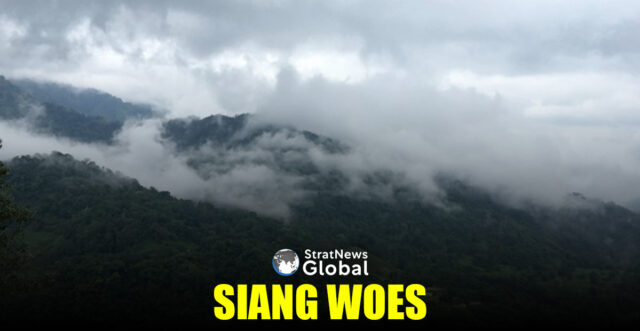Part I: Promises Vs. Power: China’s Mega Dam Contradiction
Part II : China’s Mega Dam And India’s Asymmetric Challenge
As China races ahead with the world’s largest dam on the Yarlung Tsangpo—a 60,000 MW megastructure under construction near the Great Bend—concerns are growing about its potential seismic impact on the fragile Himalayan region and the implications for water security downstream.
The project, part of Beijing’s broader infrastructure ambitions in Tibet, is being closely watched in India, where the Siang River—into which the Tsangpo flows—runs through Arunachal Pradesh before joining the Brahmaputra.
Against this backdrop, Chief Minister Pema Khandu has unveiled an ambitious plan to add 15,000 MW of hydropower capacity through 13 projects in the next three years, positioning Arunachal Pradesh as a potential “hydropower capital” of India. But as the state pushes ahead, it must also contend with intensifying local resistance, legal challenges, and environmental warnings.
One of the most controversial of these projects is the 11,500 MW Siang Upper Multipurpose Project (SUMP), which proposes a 300-metre-high dam in a geologically sensitive and ecologically rich region. Civil society groups, tribal organisations, and environmental activists have expressed alarm over the scale and potential impact of the project. They point out that it could submerge 27 villages and displace over 1.5 lakh people, mostly from the indigenous Adi tribe. For them, the river is not just a water source—it is “Ane”, or “mother,” central to their cultural and spiritual life.
The Siang basin, which includes the Dihang–Dibang Biosphere Reserve, is recognised globally for its biodiversity. Any large-scale infrastructure development here, activists warn, risks irreversible ecological damage. But the conflict is not only environmental—it is also about process. Activists argue that the Indian government is using the perceived threat of China’s upstream dam as justification for pushing ahead with its own mega-dam without adequate public consultation or consent.
Tensions have grown since early 2024. According to local activists and lawyers, both central and state governments have deployed paramilitary forces to facilitate feasibility studies for the SUMP. Bhanu Tarak, a lawyer-activist, claimed that the government was “militarising the entire region” to suppress protests, while Ebo Mili, another local lawyer, said she had been detained multiple times to prevent her from mobilising opposition to the dam.
Their concerns culminated in a letter signed by 351 environmentalists, academics, journalists, and civil society organisations, addressed to President Droupadi Murmu in December 2024. The letter called for the immediate withdrawal of security forces from project areas and urged the government to respect constitutional safeguards and environmental norms. It also questioned the rationale of proceeding with such a massive undertaking without first engaging with China to understand the hydrological implications of its upstream project.
The central government, however, appears determined to move forward. In July 2025, P.K. Mishra, Principal Secretary to the Prime Minister, convened senior officials and stakeholders to review and expedite survey work on the SUMP. The project was described as being of “national importance”—a designation that carries both symbolic and strategic weight. But for many local communities, this top-down approach only reinforces the perception that their voices are being ignored.
The result is a widening trust deficit. While the state government speaks of economic development, energy security, and strategic preparedness, many residents of the Siang valley see broken promises and a disregard for democratic process. The demand from activists is not outright rejection of hydropower, but a call for transparency, consent, and genuine dialogue. They argue that any development must be guided by the principle of free, prior, and informed consent, especially in regions protected under constitutional and environmental law.
At the heart of this unfolding drama is a deeper question: how does a democracy like India balance national interest with local rights—especially in frontier regions marked by cultural distinctiveness, ecological sensitivity, and geopolitical risk?
The Siang dam is being promoted as a shield—both literal and symbolic—against China’s upstream ambitions. But for communities in Arunachal, it is fast becoming a symbol of exclusion. They are not resisting development for its own sake. Rather, they demand a seat at the table, a say in decisions that will uproot their homes, alter their rivers, and transform their futures.
India’s response to China’s upstream dam cannot come at the cost of alienating its own citizens. The Siang project is not just about energy or strategy—it is a test of whether India can pursue national interests without sacrificing local rights and democratic processes.
In a career spanning three decades and counting, Ramananda (Ram to his friends) has been the foreign editor of The Telegraph, Outlook Magazine and the New Indian Express. He helped set up rediff.com’s editorial operations in San Jose and New York, helmed sify.com, and was the founder editor of India.com.
His work has featured in national and international publications like the Al Jazeera Centre for Studies, Global Times and Ashahi Shimbun. But his one constant over all these years, he says, has been the attempt to understand rising India’s place in the world.
He can rustle up a mean salad, his oil-less pepper chicken is to die for, and all it takes is some beer and rhythm and blues to rock his soul.
Talk to him about foreign and strategic affairs, media, South Asia, China, and of course India.





